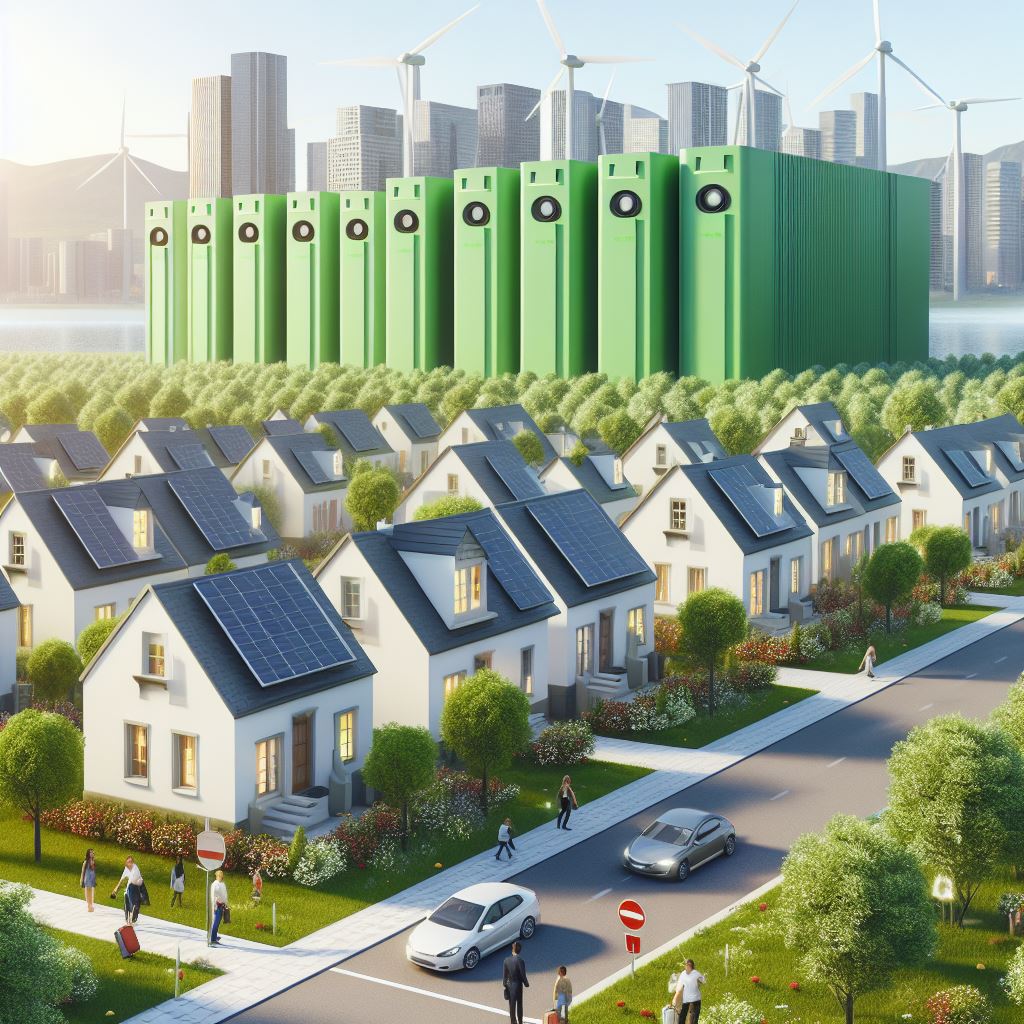
In the quest for a sustainable energy environment, green energy has emerged as a key focus area. The global power grid is currently undergoing a transformation, driven by breakthrough technologies that harness renewable energy sources such as solar power, wind power, and hydroelectricity. These innovative solutions play a vital role in mitigating the effects of climate change and ensuring a reliable energy supply for future generations.
This article delves into the science behind these cutting-edge technologies, their potential benefits and challenges, and the role of our community in promoting their adoption and integration.
The Energy Landscape: Challenges and Opportunities
Rising Energy Demand and Environmental Concerns
The world’s energy consumption continues to grow, driven by factors such as population growth, economic development, and urbanization. At the same time, concerns about climate change and the depletion of finite natural resources have intensified, highlighting the urgent need for a shift towards renewable energy sources. As the energy sector grapples with these challenges, innovative technologies and solutions hold the key to a more sustainable and secure power grid.
The Role of Renewable Energy in the Fight Against Climate Change
Renewable energy sources, such as solar, wind, and hydroelectric power, are essential in our fight against climate change. By replacing fossil fuels with clean, green energy, we can significantly reduce greenhouse gas emissions, improve air quality, and conserve our planet’s natural resources. As the global community increasingly recognizes the importance of renewable energy, cutting-edge technologies are emerging to harness and store this abundant and sustainable power.
Solar Power: Harnessing the Sun’s Abundant Energy
Photovoltaic Technology: Converting Sunlight into Electricity
Solar power has emerged as one of the most promising renewable energy sources, thanks to the development of efficient photovoltaic (PV) technology. Solar cells, or photovoltaics, convert sunlight into electricity by using semiconducting materials to absorb photons of light and release electrons, which can be captured and converted into electricity. Some solar cell designs achieve conversion efficiencies of over 40%, making solar power a highly efficient and clean energy source.
Solar energy source – pros and cons
Solar energy has emerged as a sustainable and eco-friendly alternative to traditional sources of power, with solar panels being at the forefront of this green revolution. As the world continues to grapple with the challenges of climate change and environmental degradation, solar panel technology has gained widespread attention for its potential to harness the sun’s abundant and renewable energy. In next part, we will delve into the pros and cons of solar panel technology to provide a comprehensive understanding of its impact on our energy landscape.

Pros of solar power:
- Renewable Energy Source:
- Solar panels harness energy from the sun, an infinitely renewable resource, making them a sustainable solution for the long term.
- Unlike finite fossil fuels, solar energy is inexhaustible, reducing dependence on non-renewable resources and mitigating environmental impact.
- Environmentally Friendly:
- Solar energy production generates minimal greenhouse gas emissions, contributing significantly to the reduction of air pollution and combatting climate change.
- Solar panels have a relatively low carbon footprint compared to conventional energy sources, further promoting environmental conservation.
- Low Operating Costs:
- Once installed, solar panels have low operating and maintenance costs. They require minimal upkeep and have no fuel costs, making them economically viable in the long run.
- Many governments and organizations offer financial incentives, tax credits, and subsidies to encourage the adoption of solar technology, further enhancing cost-effectiveness.
- Off-Grid Capabilities:
- Solar panels can be used in remote or off-grid areas, providing access to electricity in regions where traditional power infrastructure is impractical or unavailable.
- This capability contributes to the electrification of rural and underserved communities, improving living standards and fostering economic development.
- Job Creation:
- The solar industry has become a major source of employment, with jobs ranging from manufacturing and installation to research and development.
- The growing demand for solar technology has led to job creation on a global scale, stimulating economic growth in the renewable energy sector.
Cons of solar power:
- Intermittent Energy Production:
- Solar panels are dependent on sunlight, and energy production decreases during cloudy days or at night. This intermittency poses challenges for consistent power supply without adequate energy storage solutions.
- Efficient energy storage systems, such as batteries, are still evolving and can add to the overall cost of a solar power setup.
- High Initial Costs:
- The upfront cost of purchasing and installing solar panels can be relatively high, deterring some individuals or businesses from adopting solar technology.
- Although prices have been decreasing over the years, the initial investment remains a barrier for widespread adoption in certain regions.
- Land Use and Aesthetics:
- Large-scale solar farms may require extensive land, leading to concerns about habitat disruption and land use conflicts.
- Some people find solar panels aesthetically unpleasing, and there are debates about the impact of solar installations on the visual landscape.
- Resource and Manufacturing Impact:
- The production of solar panels involves the use of rare materials such as silicon, which raises environmental and ethical concerns related to mining and resource extraction.
- Manufacturing processes also require energy, and if not sourced sustainably, it can undermine the overall environmental benefits of solar technology.
- Limited Efficiency:
- Current solar panel technology has limitations in terms of energy conversion efficiency. While advancements are being made, the overall efficiency is still lower compared to some other energy sources.
- Improvements in efficiency are crucial to maximize the energy output and make solar power more competitive with conventional sources.
Conclusion of using solar energy as potential source of green energy:
Solar panel technology has come a long way in addressing environmental concerns and promoting sustainable energy practices. The pros of harnessing solar power, such as its renewable nature, environmental friendliness, and low operating costs, outweigh the cons for many individuals, businesses, and governments. However, challenges related to intermittency, initial costs, and resource impacts highlight the need for continued research and innovation in the solar energy sector. As technology advances, addressing these challenges will be crucial to unlocking the full potential of solar power and accelerating the transition to a cleaner, more sustainable energy future.
The Expanding Solar Energy Market
As solar power becomes increasingly popular, its market continues to expand, with the installation of rooftop solar panels, large-scale solar farms, and solar-powered community microgrids. The affordability and accessibility of solar power have significantly increased over the past decade, making it an attractive option for households, businesses, and governments alike. Solar power has the potential to reshape our energy landscape and contribute to a more sustainable future.
Wind Power: Capturing the Power of Earth’s Breezes
Wind Turbine Technology: Generating Electricity from Air Movement
Wind power is another cutting-edge renewable energy source, harnessing the kinetic energy of the wind to generate electricity. Wind turbines use the movement of air to drive a generator, with their blades rotating as the wind blows. Wind power is a clean and sustainable energy source, with no greenhouse gas emissions or other pollution during operation. In addition, wind power is highly efficient, with some wind turbines achieving capacity factors (the percentage of maximum possible output) of over 50%.
Pros and cons of wind energy
Wind turbine energy, a form of renewable energy, has gained significant attention in recent years as the world strives to transition towards sustainable and environmentally friendly power sources. While wind power has proven to be a clean and abundant energy solution, it is crucial to examine both its advantages and disadvantages to make informed decisions about its implementation.

Pros of Wind Turbine Energy:
- Clean and Renewable: One of the most significant advantages of wind turbine energy is its cleanliness and renewability. Wind is an infinite resource, and harnessing its power doesn’t produce harmful emissions or contribute to climate change, making it an environmentally friendly alternative to fossil fuels.
- Reduced Greenhouse Gas Emissions: Wind power generation results in minimal greenhouse gas emissions compared to traditional fossil fuel-based energy sources. By reducing reliance on non-renewable resources, wind turbines play a crucial role in mitigating the impact of climate change.
- Low Operating Costs: Once installed, wind turbines have relatively low operating costs. Unlike fossil fuel power plants that require ongoing fuel supplies, wind is free, making wind energy an economically viable option in the long run.
- Job Creation: The wind energy sector contributes to job creation through various stages, from manufacturing and installation to maintenance and operation. This job creation fosters economic growth and supports local communities.
- Land Use Efficiency: Wind farms can be established on agricultural land, allowing farmers to maintain their primary activities alongside energy production. This dual use of land promotes sustainability and economic benefits for rural communities.
Cons of Wind Turbine Energy:
- Intermittency and Variability: One of the significant challenges with wind energy is its intermittency. Wind speed is not constant, and turbines generate electricity only when the wind is blowing within a specific range. This variability requires backup energy sources to ensure a consistent power supply.
- Visual and Noise Impact: Wind turbines, especially in densely populated areas, can be visually and acoustically disruptive. Some people find them aesthetically unpleasing, and concerns about noise pollution have been raised, though technological advancements aim to mitigate these issues.
- Land Use and Wildlife Impact: Large wind farms can occupy significant amounts of land, potentially leading to habitat disruption and negatively impacting local wildlife. Bird and bat collisions with turbine blades are also concerns, although ongoing research seeks to develop solutions to minimize these impacts.
- High Initial Costs: While wind energy has low operating costs, the initial investment required for manufacturing, transportation, and installation of wind turbines can be substantial. Governments and private entities often need to provide financial incentives to make wind projects financially feasible.
- Transmission Challenges: Ideal wind resources are often located in remote areas, necessitating extensive transmission infrastructure to connect wind farms to urban centers. The construction of these transmission lines can face logistical and environmental challenges.
Conclusion of using wind energy as potential source of green energy:
Wind turbine energy stands as a promising solution for a sustainable and clean future. Its advantages in reducing greenhouse gas emissions, creating jobs, and harnessing an abundant resource are substantial. However, challenges such as intermittency, visual and noise impacts, and high initial costs must be addressed for widespread adoption. As technology continues to advance and policies evolve, wind energy is likely to play an increasingly vital role in the global energy mix. A balanced approach that considers both the benefits and drawbacks is essential for maximizing the positive impact of wind turbine energy on our planet.
The Growth of Wind Farms and Offshore Wind Power
Wind energy is a rapidly growing sector, with the construction of onshore and offshore wind farms to capture Earth’s abundant and variable wind resources. Offshore wind power, in particular, has gained traction due to its higher and more consistent wind speeds, resulting in greater energy output compared to onshore wind farms. As wind power continues to gain popularity, it holds great potential in reducing our reliance on fossil fuels and contributing to a greener power grid.
Hydroelectric Power: Channeling the Force of Water
Hydroelectric Facilities: Generating Electricity from Water Flow
Hydroelectric power is another innovative renewable energy solution, utilizing the movement of water to generate electricity. This can be achieved through the construction of dams to create reservoirs or by using turbines in flowing rivers. Some hydroelectric facilities achieve capacity factors of over 90%, making hydroelectric power a highly efficient and clean energy source.
Analyzing hydroelectric energy – Pros and Cons
Hydroelectric energy, derived from the force of flowing water, has long been a significant player in the world’s energy landscape. This renewable energy source harnesses the power of water to generate electricity, providing a clean and reliable alternative to conventional fossil fuels. To understand the full scope of hydroelectric power, it is essential to examine its advantages and disadvantages.

Pros of Hydroelectric energy:
- Clean and Renewable: Hydroelectric power is a clean and renewable energy source that produces electricity without emitting greenhouse gases. As long as water continues to flow, the energy potential remains infinite, making it an environmentally friendly choice.
- Reliable and Consistent Power Generation: Unlike some other renewable sources, such as wind or solar, hydroelectric power offers consistent and reliable electricity generation. The flow of water can be controlled to match energy demand, providing a stable power supply.
- Storage Capability: Many hydroelectric systems include reservoirs that act as storage for water. This stored water can be released when demand is high, acting as a flexible and efficient way to manage energy production based on changing needs.
- Long Lifecycle and Low Operating Costs: Hydroelectric power plants typically have long lifecycles and low operating costs. Once the infrastructure is in place, ongoing maintenance is generally less intensive than with some other energy sources, contributing to economic feasibility.
- Multipurpose Reservoirs: Hydroelectric projects often involve the creation of reservoirs, which can serve multiple purposes. These reservoirs can provide recreational opportunities, regulate water supply, and help control floods, enhancing the overall societal and environmental benefits.
Cons of hydroelectric energy:
- Environmental Impact: The construction of dams and reservoirs for hydroelectric projects can have significant environmental impacts. Altered river ecosystems, displacement of wildlife, and changes in water temperature and quality are among the concerns associated with these structures.
- Land Use and Habitat Disruption: The large land areas required for dams and reservoirs can lead to habitat disruption and displacement of communities. The alteration of river courses and ecosystems can have cascading effects on the environment and biodiversity.
- Upfront Capital Costs: The initial investment required for the construction of hydroelectric facilities, especially large dams, can be substantial. These upfront capital costs can present financial challenges, requiring long-term planning and significant financial resources.
- Limited Geographic Availability: Hydroelectric power is highly dependent on the availability of suitable water resources. Not all regions have the topography or water flow necessary for the effective implementation of hydroelectric projects, limiting its geographic applicability.
- Sedimentation and Reservoir Lifespan: Over time, sedimentation can reduce the effectiveness of reservoirs, decreasing their lifespan. Managing sediment buildup requires ongoing maintenance efforts and, in some cases, sediment removal, adding to operational complexities.
Conclusion of using hydroelectric energy as potential source of green energy:
Hydroelectric energy stands as a proven and reliable renewable energy source with a track record of contributing significantly to the global energy supply. While it offers numerous advantages, including cleanliness, reliability, and multipurpose reservoirs, the environmental and economic challenges associated with dam construction and habitat disruption must be carefully considered. As technology advances and environmental awareness increases, striking a balance between harnessing the power of flowing water and mitigating potential drawbacks will be essential for ensuring the continued sustainability and positive impact of hydroelectric energy.
The Scalability and Reliability of Hydroelectric Power
Hydroelectric power offers a scalable and reliable clean energy solution, with the size of dams and reservoirs determining their energy output. The technology is not only capable of powering large-scale energy projects but also has the potential to provide electricity for small communities and individual households. As hydroelectric power continues to develop, it offers a promising alternative to traditional fossil fuel-based energy.
Advanced Energy Storage and Transmission Technologies
Storing excess renewable energy for later use
As the world intensifies its efforts to transition towards cleaner and more sustainable energy sources, solar and wind power have emerged as pivotal players in the renewable energy landscape. However, the intermittent nature of these sources poses a challenge to their widespread adoption. In addressing this challenge, power storage technologies have become indispensable. This article explores the crucial role of power storage in both solar and wind energy systems, with a particular emphasis on the benefits of LiFePO4 batteries and pumped storage hydroelectricity.
In addition to breakthroughs in renewable energy production, advancements in energy storage technologies are essential for the effective integration of renewable energy into the power grid. Advanced batteries, such as lithium-ion batteries or Lithium iron phosphate (LiFePo4) can store excess renewable energy generated during peak production periods for use when required. These storage solutions help to improve the reliability and flexibility of renewable energy systems, ensuring a consistent and stable power supply.
The Challenge of Intermittency:
Solar and wind energy are subject to natural variations, such as changes in weather patterns and daily or seasonal fluctuations.
This intermittency can result in periods of excess energy production and times when energy demand exceeds supply. The integration of efficient power storage solutions is essential to bridge these gaps, ensuring a stable and reliable energy supply.

LiFePO4 Batteries: A Cutting-Edge Solution:
- High Energy Density and Efficiency: Lithium Iron Phosphate (LiFePO4) batteries have gained prominence as a preferred energy storage solution due to their high energy density and efficiency. These batteries can store large amounts of energy in a compact space, making them suitable for residential, commercial, and industrial applications.
- Long Cycle Life: LiFePO4 batteries are known for their extended cycle life, providing a reliable and durable energy storage solution. Their ability to withstand a high number of charge-discharge cycles makes them a cost-effective choice for long-term energy storage needs.
- Safety and Stability: LiFePO4 batteries are renowned for their safety features. They have a lower risk of thermal runaway and are less prone to overheating compared to some other lithium-ion batteries, ensuring a stable and secure energy storage solution.
- Fast Charging and Discharging: LiFePO4 batteries offer fast charging and discharging capabilities, enhancing their suitability for applications where quick energy response times are crucial. This feature is particularly beneficial in grid stabilization and demand management.
Pumped Storage Hydroelectricity: Harnessing Gravity for Energy Storage:
- Mechanism of Operation: Pumped storage hydroelectricity is a form of grid energy storage that utilizes the force of gravity and the movement of water. During periods of excess energy production, surplus electricity is used to pump water to an elevated reservoir. When energy demand is high, the stored water is released, flowing downhill through turbines to generate electricity.
- Large-Scale and Long-Duration Storage: Pumped storage hydroelectricity is capable of providing large-scale and long-duration energy storage. The size and capacity of the reservoirs determine the duration for which energy can be stored, making it a valuable asset for balancing the intermittent nature of solar and wind power.
- Grid Stabilization and Flexibility: The rapid response and flexibility of pumped storage hydroelectricity make it an effective tool for grid stabilization. It can quickly adjust to fluctuations in energy demand, acting as a reliable source of backup power during peak periods.
Conclusion:
Power storage is undeniably the linchpin for the successful integration of solar and wind energy into the mainstream power grid. LiFePO4 batteries, with their high energy density, safety features, and long cycle life, offer a versatile solution for decentralized energy storage needs. Simultaneously, pumped storage hydroelectricity, with its ability to store and release large amounts of energy on demand, plays a crucial role in stabilizing the grid.
As the world continues its journey towards a sustainable energy future, the development and implementation of advanced power storage technologies, such as LiFePO4 batteries and pumped storage hydroelectricity, will be pivotal in ensuring a reliable, resilient, and environmentally conscious energy infrastructure.
High-Voltage Direct Current (HVDC) Transmission Lines: Efficient Long-Distance Electricity Transmission
Another key innovation in the energy sector is the development of high-voltage direct current (HVDC) transmission lines. These advanced transmission systems enable the efficient transmission of electricity over long distances with minimal loss, allowing renewable energy generated in remote locations to be integrated into the grid. HVDC technology is a crucial component in the development of a more interconnected and resilient power grid that can accommodate the growing demand for renewable energy.
The Potential Benefits and Challenges of Cutting-Edge Energy Technologies

Environmental and Social Benefits: Reducing Emissions and Improving Air Quality
The adoption of cutting-edge renewable energy technologies offers significant environmental and social benefits. By replacing fossil fuels with clean, green energy sources, we can drastically reduce greenhouse gas emissions and improve air quality. This, in turn, can lead to better public health outcomes and contribute to global efforts to combat climate change.
Economic Benefits: Job Creation and Energy Security
The renewable energy sector is a rapidly growing industry, creating jobs in fields such as solar installation, wind turbine manufacturing, and electric vehicle production. These jobs contribute to local and national economies while promoting a shift towards more sustainable energy sources. Furthermore, by harnessing homegrown renewable energy sources, countries can reduce their dependence on imported fossil fuels, bolstering their energy security and fostering economic resilience.
Potential Challenges: High Upfront Costs, Infrastructure Development, and Technological Risks
Despite the potential benefits of adopting cutting-edge renewable energy technologies, there are also potential challenges to consider. These include the high upfront costs associated with deploying these technologies, the need for infrastructure development to support their integration, and the risks of technological failures or malfunctions. To overcome these challenges, proper regulation, oversight, and investment in research and development are essential to ensure that these technologies are used ethically and responsibly.
The Role of the Invenio Community in the Renewable Energy Revolution
The Invenio community, focused around the Invenio project, actively follows trends in the energy market and supports the adoption of innovative renewable energy sources and storage solutions. Many of our members and supporters work in state-owned energy supply companies or run their own innovative enterprises in the field of renewable energy sources and storage.
As part of our commitment to promoting a more sustainable energy future, the Invenio community plays a crucial role in the following areas:
- Raising awareness and fostering knowledge-sharing about cutting-edge renewable energy technologies and their potential benefits and challenges.
- Advocating for the adoption of renewable energy solutions in both public and private sectors, as well as supporting the development of infrastructure to enable their integration.
- Encouraging research, innovation, and collaboration in the renewable energy sector to develop more efficient and cost-effective technologies.
- Supporting the responsible and ethical use of renewable energy technologies, with a focus on minimizing environmental impacts and maximizing social and economic benefits.
By playing an active role in the renewable energy revolution, the Invenio community is helping to shape a more sustainable and secure energy future for generations to come.
Conclusion: Embracing the Renewable Energy Revolution
The science behind cutting-edge renewable energy technologies is revolutionizing the way we produce and use energy. By harnessing the power of the sun, the wind, and water, and by developing advanced technologies for energy storage and transmission, we have the opportunity to create a more sustainable and secure energy environment. While potential challenges remain, the benefits of these technologies are significant, and it is essential that we continue to invest in and support their development and integration.
As a community dedicated to promoting sustainable energy solutions, the Invenio project and its members are playing a vital role in championing the adoption of renewable energy technologies and shaping the future of our global power grid. By working together, we can create a world powered by clean, green energy that benefits both the environment and society for generations to come.







hydrogen fuel cells. These devices have the potential to store excess energy generated from renewable sources like wind or solar power, and release it as clean energy when needed. They’re still in the early stages of development, but I believe they hold a lot of promise for our future.
Thirdly, the article doesn’t address one of the most significant challenges facing our transition to a sustainable energy future: grid resilience. As we increasingly rely on renewable energy sources, our power grids will need to be designed and built to handle the variable output from these sources. This requires new technologies and infrastructure that can adapt quickly to changing energy demands.
Finally, I take issue with the article’s dismissive tone towards the challenges facing the renewable energy sector. Yes, there are many obstacles to overcome – high upfront costs, lack of infrastructure, and technological risks, among others. But we can’t just shrug these off as insurmountable barriers. We need to be proactive in addressing these challenges through innovation, research, and policy changes that support the growth of renewable energy.
In conclusion, I believe this article falls short in its vision for a sustainable energy future. While it’s true that renewable energy sources hold great promise, we need to be more ambitious and innovative in our pursuit of clean energy solutions. We can’t afford to wait – the clock is ticking on climate change, and we need to act now.